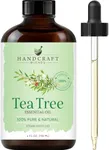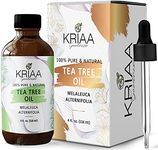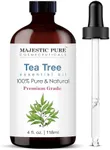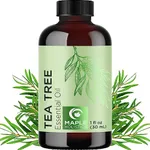Buying Guide for the Best Tea Tree Oils
Choosing the right tea tree oil can make a big difference in how effective and enjoyable it is for your needs, whether that's skincare, aromatherapy, or household use. It's important to understand what makes a good tea tree oil and how to read the labels so you can pick a product that matches your intended use. By focusing on a few key specifications, you can ensure you get a high-quality oil that is safe and effective.PurityPurity refers to whether the tea tree oil is 100% pure or if it has been mixed with other oils or substances. Pure tea tree oil is generally more potent and effective, especially for therapeutic or medicinal uses. Some products are diluted for safety or cost reasons, which can be fine for certain uses like cleaning or mild skin applications. If you want the full benefits, look for oils labeled as 100% pure. If you have sensitive skin or are using it for children, a diluted version might be safer. Always check the ingredient list to see if anything else has been added.
Source and OriginThe source and origin indicate where the tea tree plants were grown and how the oil was harvested. Tea tree oil is most commonly sourced from Australia, where the plant is native, and oils from this region are often considered high quality. Some oils come from other countries, which can affect the scent and effectiveness. If you want the most traditional and potentially potent oil, look for one that specifies Australian origin. For general household use, the origin may be less important.
Extraction MethodThe extraction method describes how the oil is taken from the tea tree leaves. Steam distillation is the most common and preferred method because it preserves the natural properties of the oil without using chemicals. Other methods might involve solvents, which can leave residues and affect purity. If you want a natural and safe product, choose oils that mention steam distillation. For less critical uses, the extraction method may not be as important.
Concentration of Terpinen-4-olTerpinen-4-ol is the main active ingredient in tea tree oil and is responsible for most of its benefits. A higher concentration (usually between 30-40%) means a more effective oil for things like acne or fungal infections. Lower concentrations might be gentler for sensitive skin or everyday use. Check the label for this information if you need the oil for specific therapeutic purposes. For general cleaning or aromatherapy, the exact percentage is less critical.
PackagingPackaging refers to the type of container the oil comes in. Tea tree oil should be stored in dark glass bottles, like amber or cobalt blue, to protect it from light and air, which can degrade the oil over time. Plastic bottles or clear glass can lead to faster spoilage. If you want your oil to last and stay effective, always choose products in dark glass bottles with tight-fitting caps.
Certification and TestingCertification and testing indicate whether the oil has been tested for quality and purity by a third party or has organic certification. This can give you extra confidence that the oil is free from contaminants and meets certain standards. If you are using tea tree oil for health or skincare, look for certifications like organic or third-party lab testing. For less sensitive uses, this may be less important.


















